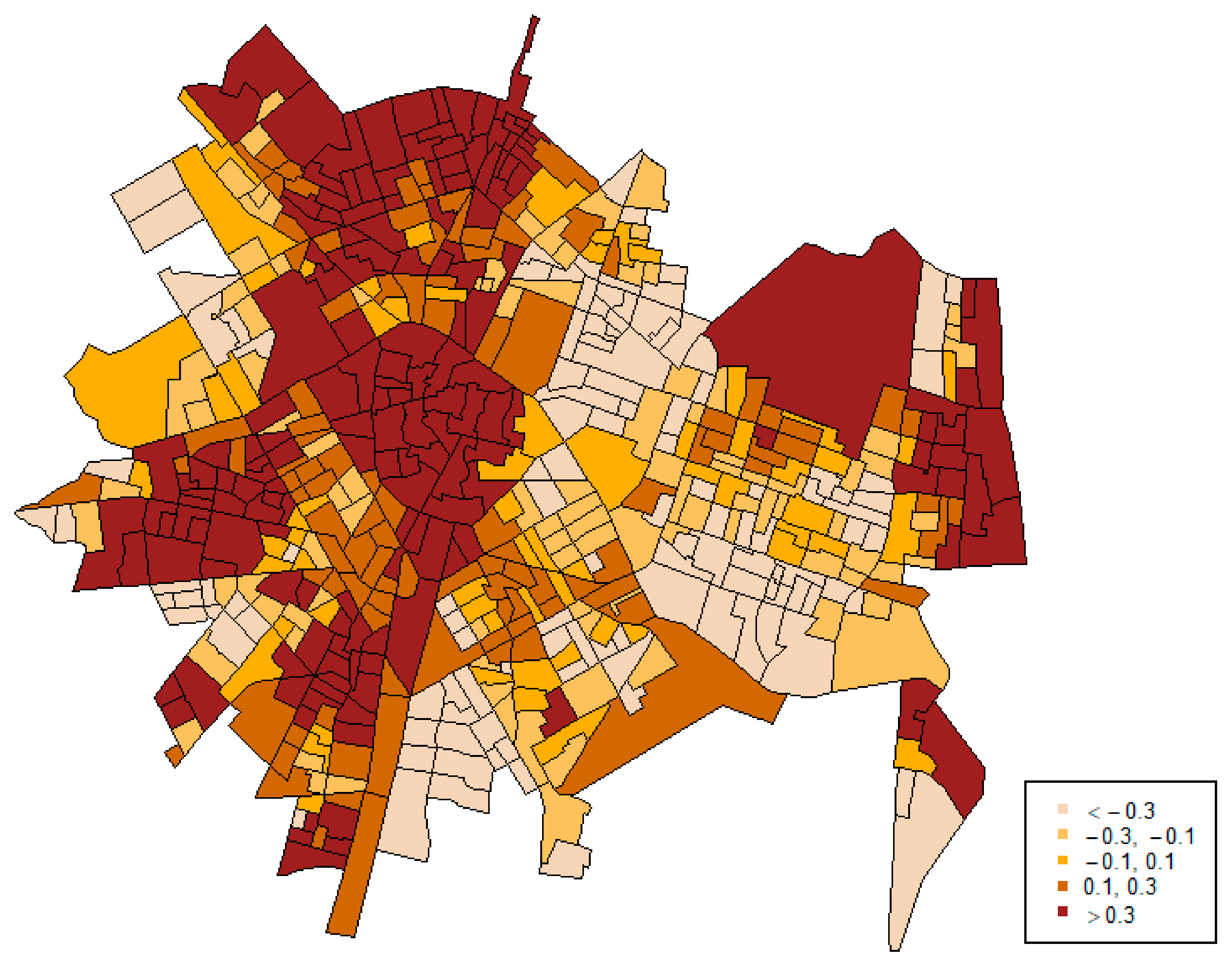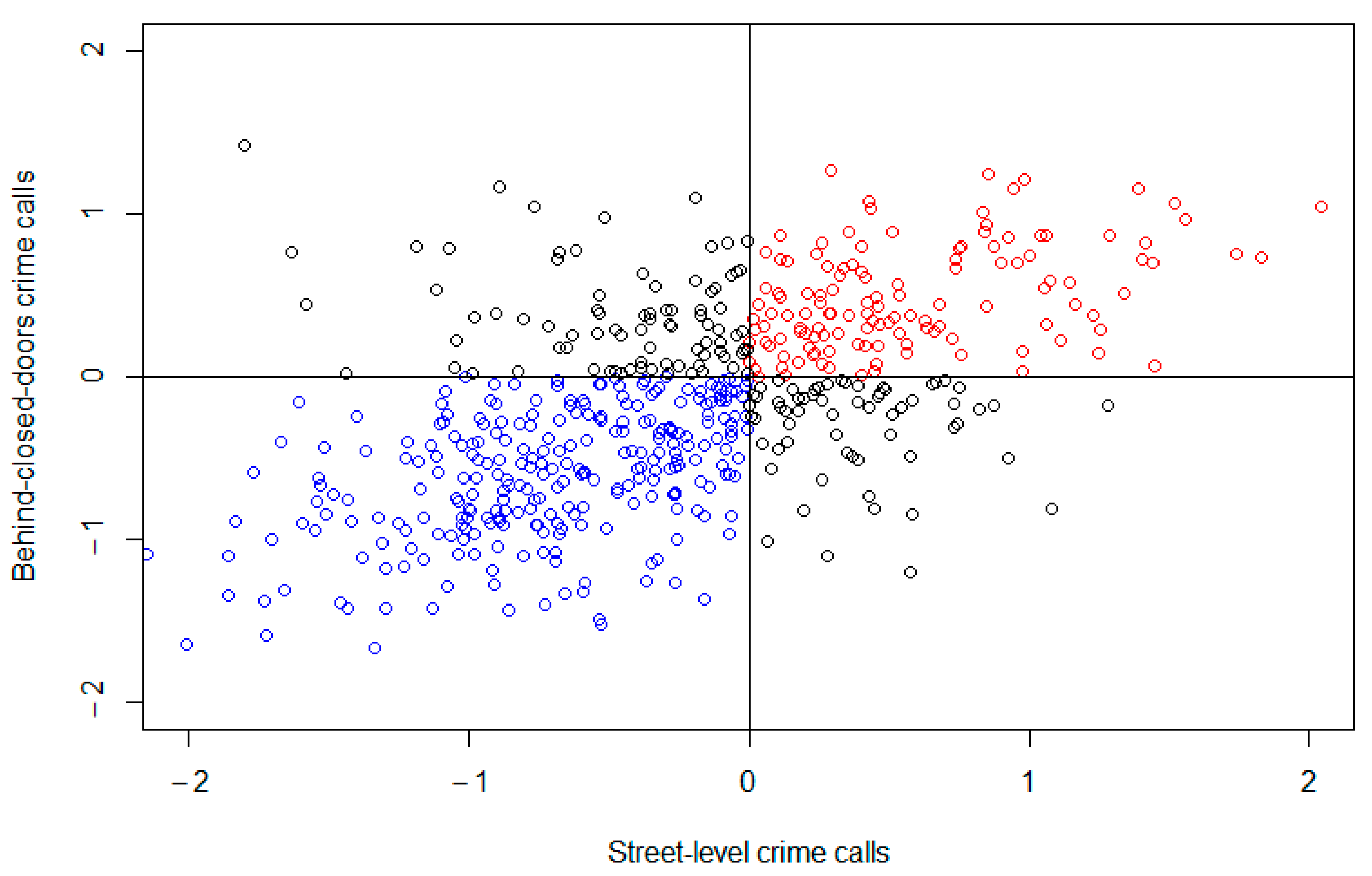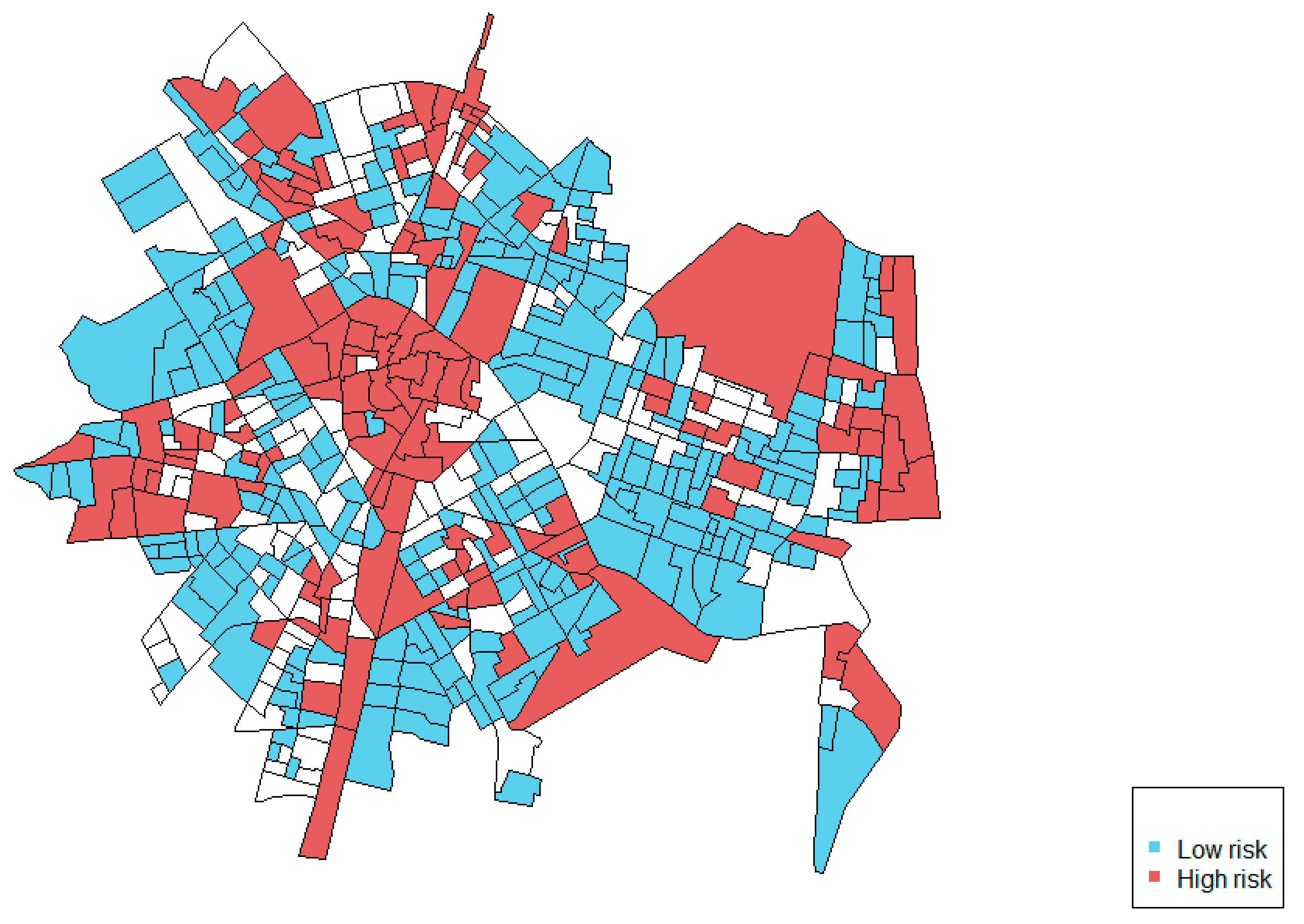The Spatial Overlap of Police Calls Reporting Street-Level and Behind-Closed-Doors Crime: A Bayesian Modeling Approach
Abstract
1. Introduction
2. Materials and Methods
2.1. Data and Study Area
2.2. Data Analysis
2.2.1. Joint Spatial Modeling
2.2.2. Spatial Regression Modeling
2.2.3. Bayesian Inference
3. Results
3.1. Spatial Joint Modeling
3.2. Spatial Regression Modeling
4. Discussion
5. Conclusions
Author Contributions
Funding
Institutional Review Board Statement
Informed Consent Statement
Data Availability Statement
Conflicts of Interest
References
- Caplan, J.M.; Kennedy, L.W.; Piza, E.L. Joint Utility of Event-Dependent and Environmental Crime Analysis Techniques for Violent Crime Forecasting. Crime Delinq. 2013, 59, 243–270. [Google Scholar] [CrossRef]
- Deryol, R.; Wilcox, P.; Logan, M.; Wooldredge, J. Crime places in context: An illustration of multilevel natura of hot spot development. J. Quant. Criminol. 2016, 32, 305–325. [Google Scholar] [CrossRef]
- Ratcliffe, J.H.; McCullagh, M.J. Chasing ghosts? Police perception of high crime areas. Brit. J. Criminol. 2001, 41, 330–341. [Google Scholar] [CrossRef]
- Groff, E.; Weisburd, D.; Morris, N.A. Where the Action is at Places: Examining Spatio-Temporal Patterns of Juvenile Crime at Places Using Trajectory Analysis and GIS. In Putting Crime in Its Place: Units of Analysis in Criminology; Weisburd, D., Bernasco, W., Bruinsma, G., Eds.; Springer: New York, NY, USA, 2009; pp. 61–86. [Google Scholar]
- Haining, R.; Law, J.; Griffith, D. Modelling small area counts in the presence of overdispersion and spatial autocorrelation. Comput. Stat. Data Anal. 2009, 53, 2923–2937. [Google Scholar] [CrossRef]
- Law, J.; Quick, M.; Chan, P. Bayesian Spatio-Temporal Modeling for Analysing Local Patterns of Crime Over Time at the Small-Area Level. J. Quant. Criminol. 2014, 30, 57–78. [Google Scholar] [CrossRef]
- Matthews, S.A.; Yuang, T.-C.; Hayslett, K.L.; Ruback, R.B. Built environment and property crime in Seattle, 1998–2000: A Bayesian analysis. Environ. Plann. A 2010, 42, 1403–1420. [Google Scholar] [CrossRef] [PubMed]
- Sparks, C.S. Violent crime in San Antonio, Texas: An application of spatial epidemiological methods. Spat. Spatio Temporal Epidemiol. 2011, 2, 301–309. [Google Scholar] [CrossRef]
- Lawson, A.B. Bayesian Disease Mapping: Hierarchical Modelling in Spatial Epidemiology, 3rd ed.; CRC Press: Boca Raton, FL, USA, 2018. [Google Scholar]
- Bernardinelli, L.; Clayton, D.; Pascutto, C.; Montomoli, C.; Ghislandi, M.; Songini, M. Bayesian analysis of space—Time variation in disease risk. Stat. Med. 1995, 14, 2433–2443. [Google Scholar] [CrossRef]
- Best, N.; Richardson, S.; Thomson, A. A comparison of Bayesian spatial models for disease mapping. Stat. Methods Med. Res. 2005, 14, 35–59. [Google Scholar] [CrossRef]
- Mair, C.; Gruenewald, P.J.; Ponicki, W.R.; Remer, L. Varying Impacts of Alcohol Outlet Densities on Violent Assaults: Explaining Differences Across Neighborhoods. J. Stud. Alcohol Drugs 2013, 74, 50–58. [Google Scholar] [CrossRef]
- Toomey, T.L.; Erickson, D.J.; Carlin, B.P.; Lenk, K.M.; Quick, H.S.; Jones, A.M.; Harwood, E.M. The association between density of alcohol establishments and violent crime within urban neighborhoods. Alcohol. Clin. Exp. Res. 2012, 36, 1468–1473. [Google Scholar] [CrossRef] [PubMed]
- Zhu, L.; Gorman, D.M.; Horel, S. Hierarchical Bayesian spatial models for alcohol availability, drug “hot spots” and violent crime. Int. J. Health Geogr. 2006, 5, 54. [Google Scholar] [CrossRef]
- Lum, C. The geography of drug activity and violence: Analyzing crime event types. Subst. Use Misuse 2008, 43, 195–218. [Google Scholar]
- Marco, M.; Gracia, E.; López-Quílez, A. Linking Neighborhood Characteristics and Drug-Related Police Interventions: A Bayesian Spatial Analysis. ISPRS Int. J. Geo-Inf. 2017, 6, 65. [Google Scholar] [CrossRef]
- Li, G.; Haining, R.; Richardson, S.; Best, N. Space–time variability in burglary risk: A Bayesian spatio-temporal modelling approach. Spat. Stat. 2014, 9, 180–191. [Google Scholar] [CrossRef]
- Liu, H.; Zhu, X.; Zhang, D.; Liu, Z. Investigating Contextual Effects on Burglary Risks: A Contextual Effects Model Built Based on Bayesian Spatial Modeling Strategy. ISPRS Int. J. Geo-Inf. 2019, 8, 488. [Google Scholar] [CrossRef]
- Law, J.; Chan, P.W. Bayesian Spatial Random Effect Modelling for Analysing Burglary Risks Controlling for Offender, Socioeconomic, and Unknown Risk Factors. Appl. Spat. Anal. Policy 2012, 5, 73–96. [Google Scholar] [CrossRef]
- Rey, S.J.; Mack, E.A.; Koschinsky, J. Exploratory Space–Time Analysis of Burglary Patterns. J. Quant. Criminol. 2012, 28, 509–531. [Google Scholar] [CrossRef]
- Law, J.; Quick, M. Exploring links between juvenile offenders and social disorganization at a large map scale: A Bayesian spatial modeling approach. J. Geogr. Syst. 2013, 15, 89–113. [Google Scholar] [CrossRef]
- Bursik, R.J.; Grasmick, H.G. Neighborhoods and Crime: The Dimensions of Effective Community Control; Lexington: New York, NY, USA, 1993. [Google Scholar]
- Sampson, R.J.; Raudenbush, S.W.; Earls, F. Neighborhoods and Violent Crime: A Multilevel Study of Collective Efficacy. Science 1997, 277, 918–924. [Google Scholar] [CrossRef]
- Cunradi, C.B.; Mair, C.; Ponicki, W.; Remer, L. Alcohol Outlets, Neighborhood Characteristics, and Intimate Partner Violence: Ecological Analysis of a California City. J. Hered. 2011, 88, 191–200. [Google Scholar] [CrossRef]
- Gracia, E.; Marco, M.; López-Quílez, A.; Lila, M. Chronic high risk of intimate partner violence against women in disadvantaged neighborhoods: An eight-year space-time analysis. Prev. Med. 2021, 148, 106550. [Google Scholar] [CrossRef]
- Gracia, E.; López-Quílez, A.; Marco, M.; Lladosa, S.; Lila, M. The Spatial Epidemiology of Intimate Partner Violence: Do Neighborhoods Matter? Am. J. Epidemiol. 2015, 182, 58–66. [Google Scholar] [CrossRef]
- Marco, M.; Gracia, E.; López-Quílez, A. The university campus environment as a protective factor for intimate partner violence against women: An exploratory study. J. Community Psychol. 2018, 46, 903–916. [Google Scholar] [CrossRef]
- Barzoza, G.E. The geography of child maltreatment: A spatiotemporal analysis using Bayesian hierarchical analysis with Integrated Nested Laplace Approximation. J. Interpers. Violence 2019, 34, 50–80. [Google Scholar] [CrossRef] [PubMed]
- Freisthler, B.; Weiss, R. E Using Bayesian space-time models to understand the substance use environment and risk for being referred to child protective service. Subst. Use Misuse 2008, 43, 239–251. [Google Scholar] [CrossRef]
- Gracia, E.; López-Quílez, A.; Marco, M.; Lila, M. Mapping child maltreatment risk: A 12-year spatio-temporal analysis of neighborhood influences. Int. J. Health Geogr. 2017, 16, 38. [Google Scholar] [CrossRef]
- Marco, M.; Gracia, E.; López-Quílez, A.; Freisthler, B. Child maltreatment and alcohol outlets in Spain: Does the country drinking culture matters? Child Abus. Negl. 2019, 91, 23–30. [Google Scholar] [CrossRef]
- Morris, M.C.; Marco, M.; Maguire-Jack, K.; Kouros, C.D.; Bailey, B.; Ruiz, E.; Im, W. Connecting Child Maltreatment Risk with Crime and Neighborhood Disadvantage Across Time and Place: A Bayesian Spatiotemporal Analysis. Child Maltreat. 2018, 24, 181–192. [Google Scholar] [CrossRef]
- Morris, M.C.; Marco, M.; Bailey, B.; Ruiz, E.; Im, W.; Goodin, B. Opioid prescription rates and risk for substantiated child abuse and neglect: A Bayesian spatiotemporal analysis. Drug Alcohol Depend. 2019, 205, 107623. [Google Scholar] [CrossRef] [PubMed]
- Wright, E.M.; Benson, M.L. Clarifying the Effects of Neighborhood Context on Violence “Behind Closed Doors”. Justice Q. 2011, 28, 775–798. [Google Scholar] [CrossRef]
- Bursik, R.J. The informal social control of crime through neighborhood networks. Sociol. Focus 1999, 32, 85–97. [Google Scholar] [CrossRef]
- Browning, C.R. The Span of Collective Efficacy: Extending Social Disorganization Theory to Partner Violence. J. Marriage Fam. 2002, 64, 833–850. [Google Scholar] [CrossRef]
- Sampson, R.J.; Raudenbush, S.W. Systematic Social Observation of Public Spaces: A New Look at Disorder in Urban Neighborhoods. Am. J. Sociol. 1999, 105, 605–651. [Google Scholar] [CrossRef]
- Cunradi, C.B.; Mair, C.; Ponicki, W.; Remer, L. Alcohol Outlet Density and Intimate Partner Violence-Related Emergency Department Visits. Alcohol. Clin. Exp. Res. 2012, 36, 847–853. [Google Scholar] [CrossRef]
- Sumetsky, N.; Burke, J.G.; Mair, C. Relationships between Opioid-Related Hospitalizations and Intimate Partner Violence and Child Maltreatment Hospitalizations in Pennsylvania Across Space and Time. J. Interpers. Violence 2020. [Google Scholar] [CrossRef] [PubMed]
- Chung, J.; Kim, H. Crime Risk Maps: A Multivariate Spatial Analysis of Crime Data. Geogr. Anal. 2019, 51, 475–499. [Google Scholar] [CrossRef]
- Law, J.; Quick, M.; Jadavji, A. A Bayesian spatial shared component model for identifying crime-general and crime-specific hotspots. Ann. GIS 2020, 26, 65–79. [Google Scholar] [CrossRef]
- Liu, H.; Zhu, X. Joint Modeling of Multiple Crimes: A Bayesian Spatial Approach. ISPRS Int. J. Geo-Inf. 2017, 6, 16. [Google Scholar] [CrossRef]
- Quick, M.; Li, G.; Brunton-Smith, I. Crime-general and crime-specific spatial patterns: A multivariate spatial analysis of four crime types at the small-area scale. J. Crim. Justice 2018, 58, 22–32. [Google Scholar] [CrossRef]
- Gracia, E.; López-Quílez, A.; Marco, M.; Lila, M. Neighborhood characteristics and violence behind closed doors: The spatial overlap of child maltreatment and intimate partner violence. PLoS ONE 2018, 13, e0198684. [Google Scholar] [CrossRef] [PubMed]
- Marco, M.; Maguire-Jack, K.; Gracia, E.; López-Quílez, A. Disadvantaged neighborhoods and the spatial overlap of substantiated and unsubstantiated child maltreatment referrals. Child Abus. Negl. 2020, 104, 104477. [Google Scholar] [CrossRef] [PubMed]
- Marco, M.; Gracia, E.; Tomás, J.M.; López-Quílez, A. Assessing neighborhood disorder: Validation of a three-factor observational scale. Eur. J. Psychol. Appl. Leg. Context 2015, 7, 81–89. [Google Scholar] [CrossRef]
- Marco, M.; Freisthler, B.; Gracia, E.; López-Quílez, A.; Lila, M. Neighborhood Characteristics, Alcohol Outlet Density, and Alcohol-Related Calls-for-Service: A Spatiotemporal Analysis in a Wet Drinking Country. ISPRS Int. J. Geo-Inf. 2017, 6, 380. [Google Scholar] [CrossRef]
- Knorr-Held, L.; Best, N.G. A shared component model for detecting joint and selective clustering of two diseases. J. R. Stat. Soc. Ser. A Stat. Soc. 2001, 164, 73–85. [Google Scholar] [CrossRef]
- Besag, J.; York, J.; Mollié, A. Bayesian image restoration, with two applications in spatial statistics. Ann. Inst. Stat. Math. 1991, 43, 1–20. [Google Scholar] [CrossRef]
- Gelman, A.; Carlin, J.B.; Stern, H.S.; Dunson, D.B.; Vehtari, A.; Rubin, D.B. Bayesian Data Analysis, 3rd ed.; CRC Press: Boca Raton, FL, USA, 2013. [Google Scholar]
- Quick, M.; Li, G.; Law, J. Spatiotemporal Modeling of Correlated Small-Area Outcomes: Analyzing the Shared and Type-Specific Patterns of Crime and Disorder. Geogr. Anal. 2019, 51, 221–248. [Google Scholar] [CrossRef]
- Vicente, G.; Goicoa, T.; Ugarte, M.D. Bayesian inference in multivariate spatio-temporal areal models using INLA: Analysis of gender-based violence in small areas. Stoch. Environ. Res. Risk Assess. 2020, 34, 1421–1440. [Google Scholar] [CrossRef]
- Newton, A.; Felson, M. Crime patterns in time and space: The dynamics of crime opportunities in urban areas. Crime Sci. 2015, 4, 11. [Google Scholar] [CrossRef]
- Summers, L.; Johnson, S.D. Does the Configuration of the Street Network Influence Where Outdoor Serious Violence Takes Place? Using Space Syntax to Test Crime Pattern Theory. J. Quant. Criminol. 2017, 33, 397–420. [Google Scholar] [CrossRef]
- De Melo, S.N.; Andresen, M.A.; Matias, L.F. Geograpy of cime in a Brazilian context: An application of social disorganization theory. Urban Geogr. 2017, 38, 1550–1572. [Google Scholar] [CrossRef]
- Jones, R.W.; Pridemore, W.A. Toward an Integrated Multilevel Theory of Crime at Place: Routine Activities, Social Disorganization, and The Law of Crime Concentration. J. Quant. Criminol. 2018, 35, 543–572. [Google Scholar] [CrossRef]
- Bernasco, W.; Kooistra, T. Effects of residential history on commercial robbers’ crime location choices. Eur. J. Criminol. 2010, 7, 251–265. [Google Scholar] [CrossRef]
- Chainey, S.P.; da Silva, B.F. Examining the extent of repeat and near repeat victimization of domestic burglaries in Belo Horizonte, Brazil. Crime Sci. 2016, 5, 1. [Google Scholar] [CrossRef]
- Hoppe, L.; Gerell, M. Near-repeat burglary patterns in Malmö: Stability and change over time. Eur. J. Criminol. 2018, 16, 3–17. [Google Scholar] [CrossRef]
- Andresen, M.A. A spatial analysis of crime in Vancouver, British Columbia: A synthesis of social disorganization and routine activity theory. Can. Geogr. 2006, 50, 487–502. [Google Scholar] [CrossRef]
- Groff, E.R. Adding the Temporal and Spatial Aspects of Routine Activities: A Further Test of Routine Activity Theory. Secur. J. 2008, 21, 95–116. [Google Scholar] [CrossRef]
- Hu, Y.; Wang, F.; Guin, C.; Zhu, H. A spatio-temporal kernel density estimation framework for predictive crime hotspot mapping and evaluation. Appl. Geogr. 2017, 99, 89–97. [Google Scholar] [CrossRef]
- Andresen, M.A.; Hodgkinson, T. Predicting Property Crime Risk: An Application of Risk Terrain Modeling in Vancouver, Canada. Eur. J. Crim. Policy Res. 2018, 24, 373–392. [Google Scholar] [CrossRef]
- Caplan, J.M.; Kennedy, L.W. Risk Terrain Modeling; Crime Prediction and Risk Reduction; University of California Press: Oakland, CA, USA, 2016. [Google Scholar]
- Kennedy, L.W.; Caplan, J.M.; Piza, E. Risk Clusters, Hotspots, and Spatial Intelligence: Risk Terrain Modeling as an Algorithm for Police Resource Allocation Strategies. J. Quant. Criminol. 2011, 27, 339–362. [Google Scholar] [CrossRef]
- Mahfoud, M.; Bernasco, W.; Bhulai, S.; van der Mei, R. Forecasting Spatio-Temporal Variation in Residential Burglary with the Integrated Laplace Approximation Framework: Effects of Crime Generators, Street Networks, and Prior Crimes. J. Quant. Criminol. 2020, 1–28. [Google Scholar] [CrossRef]
- Groff, E.R.; Lockwood, B. Criminogenic facilities and crime across street segments in Philadelphia: Uncovering evidence about the spatial extent of facility influence. J. Res. Crime Delinq. 2014, 51, 277–314. [Google Scholar] [CrossRef]
- Steenbeek, W.; Weisburd, D. Where the action is in crime? An examination of variability of crime across different spatial units in the Hague, 2001–2009. J. Quant. Criminol. 2016, 32, 449–469. [Google Scholar] [CrossRef]




| Variable | Mean | SD | (Min, Max) |
|---|---|---|---|
| Mean income (€) | 12,285 | 4031.33 | (5170, 29,364) |
| Education (0–4) | 3.15 | 0.33 | (2.39, 3.86) |
| Vulnerability (1–5) | 3.07 | 0.34 | (1.77, 3.95) |
| Physical disorder (0–32) | 8.88 | 5.13 | (0, 26) |
| Physical decay (0–16) | 3.04 | 2.79 | (0, 14) |
| Vacant lots (%) | 1.03 | 3.11 | (0, 63.71) |
| Immigration (%) | 15.16 | 7.31 | (3.13, 49.05) |
| Residential instability (per 1000 inhabitants) | 229.70 | 91.18 | (62.00, 606.00) |
| Off-premise density (per km2) | 55.13 | 66.8 | (0, 744.04) |
| Restaurant/café density (per km2) | 48.83 | 72.2 | (0, 581.66) |
| Bar density (per km2) | 154.06 | 127.3 | (0, 940.88) |
| Street-level crime calls (per 1000 inhabitants) | 402.97 | 43.00 | (2.23, 402.97) |
| IPVAW calls (per 1000 inhabitants) | 16.19 | 11.40 | (0.00, 67.46) |
| Mean | SD | CrI 95% | |
|---|---|---|---|
| 0.222 | 0.781 | −0.46, 2.476 | |
| 0.27 | 0.749 | −0.373, 2.42 | |
| 1.004 | 0.068 | 0.911, 1.192 | |
| 0.665 | 0.124 | 0.542, 0.994 | |
| 0.911 | 0.131 | 0.59, 0.999 |
| Street Level Crime | IPV Calls | |||
|---|---|---|---|---|
| Variable | Mean (SD) | 95% CrI | Mean (SD) | 95% CrI |
| −0.977 (0.683) | −2.363, 0.369 | −0.228 (0.585) | −1.311, 0.948 | |
| Mean income | 0.449 (0.178) | 0.108, 0.813 | 0.086 (0.191) | −0.287, 0.444 |
| Education | −0.077 (0.206) | −0.498, 0.336 | −0.256 (0.192) | −0.615, 0.146 |
| Vulnerability | −0.005 (0.097) | −0.187, 0.188 | 0.078 (0.091) | −0.111, 0.253 |
| Immigration | 0.008 (0.009) | −0.010, 0.025 | 0.013 (0.009) | −0.003, 0.030 |
| Physical disorder | 0.011 (0.010) | −0.009, 0.031 | 0.010 (0.009) | −0.009, 0.027 |
| Physical decay | 0.009 (0.018) | −0.027, 0.044 | 0.009 (0.017) | −0.025, 0.043 |
| Vacant lots | 0.009 (0.009) | −0.009, 0.026 | 0.002 (0.009) | −0.016, 0.018 |
| Immigration | 0.008 (0.009) | −0.010, 0.025 | 0.013 (0.009) | −0.003, 0.030 |
| Residential instability | 0.001 (0.001) | 0.000, 0.002 | 0.001 (0.001) | 0.000, 0.002 |
| Off-premise density | 0.000 (0.000) | −0.001, 0.001 | 0.000 (0.000) | −0.001, 0.001 |
| Bar density | −0.001 (0.000) | −0.001, 0.000 | −0.001 (0.000) | −0.001, 0.000 |
| Restaurants-cafés density | 0.000 (0.000) | −0.001, 0.001 | 0.000 (0.000) | −0.001, 0.001 |
| 0.889 (0.189) | 0.567, 1.245 | 0.683 (0.118) | 0.470, 0.941 | |
| 0.441 (0.074) | 0.297, 0.569 | 0.460 (0.045) | 0.365, 0.541 | |
Publisher’s Note: MDPI stays neutral with regard to jurisdictional claims in published maps and institutional affiliations. |
© 2021 by the authors. Licensee MDPI, Basel, Switzerland. This article is an open access article distributed under the terms and conditions of the Creative Commons Attribution (CC BY) license (https://creativecommons.org/licenses/by/4.0/).
Share and Cite
Marco, M.; Gracia, E.; López-Quílez, A.; Lila, M. The Spatial Overlap of Police Calls Reporting Street-Level and Behind-Closed-Doors Crime: A Bayesian Modeling Approach. Int. J. Environ. Res. Public Health 2021, 18, 5426. https://doi.org/10.3390/ijerph18105426
Marco M, Gracia E, López-Quílez A, Lila M. The Spatial Overlap of Police Calls Reporting Street-Level and Behind-Closed-Doors Crime: A Bayesian Modeling Approach. International Journal of Environmental Research and Public Health. 2021; 18(10):5426. https://doi.org/10.3390/ijerph18105426
Chicago/Turabian StyleMarco, Miriam, Enrique Gracia, Antonio López-Quílez, and Marisol Lila. 2021. "The Spatial Overlap of Police Calls Reporting Street-Level and Behind-Closed-Doors Crime: A Bayesian Modeling Approach" International Journal of Environmental Research and Public Health 18, no. 10: 5426. https://doi.org/10.3390/ijerph18105426
APA StyleMarco, M., Gracia, E., López-Quílez, A., & Lila, M. (2021). The Spatial Overlap of Police Calls Reporting Street-Level and Behind-Closed-Doors Crime: A Bayesian Modeling Approach. International Journal of Environmental Research and Public Health, 18(10), 5426. https://doi.org/10.3390/ijerph18105426








